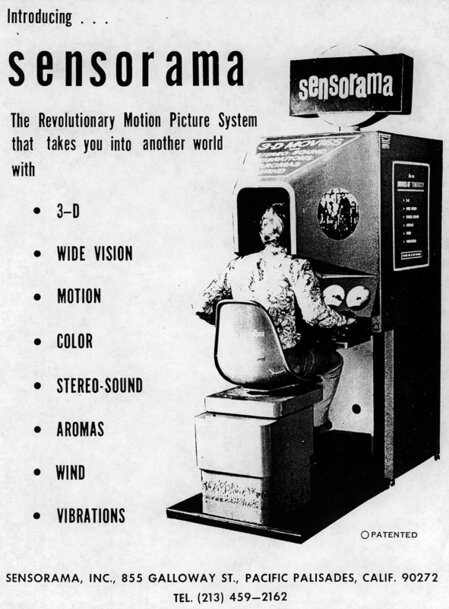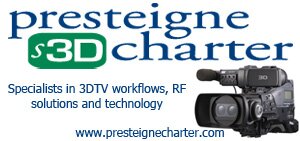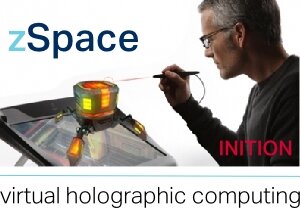World’s first virtual reality machine yours for $1.5 million
1957 saw the launch of Morton Heilig’s (1926-1997) Sensorama machine – a multi-sensory “Experience Theatre” that combined stereoscopic visuals with physical sensations and it can now be yours.

Sensorama motion picture camera
3D Focus would like to thank Marianne Heilig, the widow of Morton Heilig, for her contribution to this feature.
Known as one of the earliest examples of multimodal technology, ‘Father of Virtual Reality’ Morton Heilig produced five immersive experiences for the simulator. A single user could spend two minutes and a token to enjoy wide-angled stereoscopic visuals, stereo sound, motion, wind and scent, triggered by tracks in the film, all from the comfort of the included chair. To capture the specialist footage, Morton developed a side-by-side dual film 35mm 3-D motion picture camera, with capacity for two 400 ft magazines. This camera was small enough to be hand-held.
Morton Heilig was a cinema visionary, American cinematographer, theorist and inventor. In his 1955 essay, "The Cinema of the Future," he spoke about how all senses would be stimulated in the future – not just sound and vision. He was inspired by the ultra-widescreen Cinerama and 3D formats believing them to be the next logical step in motion picture presentation.
Many of Heilig’s ideas did not attract Hollywood funding so he chose to develop the Sensorama Simulator himself.
The two minute films cost 25 cents to view and were played on a loop. They consisted of a series of journeys, including a motorcycle ride through Brooklyn (complete with seat vibrations mimicking the motor of the bike, the smell of baking pizza and voices of people walking down sidewalks – you can see the Pan-Am building, symbolic of the era) and a view of a belly-dancer (with whiffs of perfume). The other titles were DUNE BUGGY, HELICOPTER and A DATE WITH SABINA all of which he produced, directed and edited. Phsical effects were activuated by trigger points by a magnetic strip on the doublewide film.
FREE WEEKLY 3D NEWS VIA RIGHT SIDE BAR BOX
Howard Rheingold, in his 1991 book Virtual Reality: Exploring the Brave New Technologies, described his own usage of the Sensorama, 30 years after its invention:
“By virtue of its longevity, it was a time machine of sorts. I sat down, put my hands and eyes and ears in the right places, and peered through the eyes of a motorcycle passenger at the streets of a city as they appeared decades ago. For thirty seconds, in southern California, the first week of March, 1990, I was transported to the driver's seat of a motorcycle in Brooklyn in the 1950s. I heard the engine start. I felt a growing vibration through the handlebar, and the 3D photo that filled much of my view came alive, animating into a yellowed, scratchy, but still effective 3D motion picture. I was on my way through the streets of a city that hasn't looked like this for a generation. It didn't make me bite my tongue or scream aloud, but that wasn't the point of Sensorama. It was meant to be a proof of concept, a place to start, a demo. In terms of VR history, putting my hands and head into Sensorama was a bit like looking up the Wright Brothers and taking their original prototype out for a spin.”

Telesphere Mask
Morton worked on other virtual reality devices, clocking up over 100 inventions in his lifetime. His first awarded patent was for the Telesphere Mask in 1960, the first ever head-mounted display, which provided stereoscopic visuals, wide vision and true stereo sound (not too dissimilar of the Sony Visor).
Morton followed the Sensorama with a version suitable for a larger audience. The Experience Theatre, patented in 1969, presented 3D movies on a large semi-spherical screen, with peripheral imagery, directional sound, aromas, wind, temperature variations and body tilting of the seat – in many ways similar to today’s 4D cinema attractions.
The 100% mechanical Sensorama is still operational today and has been put on the market by his widow wife, but not for loose change. Offers are requested in the region of $1.5 million (about £950,000).
For more information click here
MORTON HIGHLIGHTS
SENSORAMA MOTION PICTURE PROJECTOR – A closed loop 35 mm projector capable of projecting a 10 minute 35mm film 16,000 times (the formerrecord was 2000 times)
THRILLERAMA THEATER – Rear Projected 3-D motion picture system with live actors in front of the screen, interacting with teh 3-D images on the screen.
HASSELBLAD 3-D CAMERA MOUNT- Designed for shooting large 3-D stills with side-by-side Hasselblad cameras.
HASSELBLAD 3-D CAMERA MOUNT- Designed for shooting large 3-D stills with side-by-side Hasselblad cameras.
PIG PIX 3-D VIEWER – A still viewer, that presents large peripheral 3-D images, which could be folded flat and sent through the mail.
FREE WEEKLY 3D NEWS BULLETIN –




















